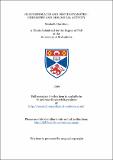Files in this item
Glucosinolates and isothiocyanates : chemistry and biological activity
Item metadata
| dc.contributor.advisor | Botting, Nigel | |
| dc.contributor.author | Davidson, Nicola E. | |
| dc.coverage.spatial | 290 p. | en_US |
| dc.date.accessioned | 2018-06-19T09:06:15Z | |
| dc.date.available | 2018-06-19T09:06:15Z | |
| dc.date.issued | 1999 | |
| dc.identifier.uri | https://hdl.handle.net/10023/14230 | |
| dc.description.abstract | The ability of glucosinolates to act as host recognition cues and oviposition stimulants for root flies has been previously established. To further investigate the interactions between pest and glucosinolate a number of simple and complex glucosinolates were synthesised and tested by contact chemoreception. A crude structure-activity relationship was identified whereby the stimulatory activity of the glucosinolate increased as the alkyl side chain was increased from propyl to pentyl, heptyl and nonyl. Comparison of the novel synthetic glucosinolate, naphthylmethyl glucosinolate, with glucobrassicin, a naturally occurring indole derivative, showed the former to have little or no activity whereas the latter is the most active natural stimulant. The synthetic glucosinolates were also demonstrated to act as substrates for the enzyme myrosinase, being hydrolysed to ?-D-glucose and the corresponding isothiocyanate. In addition, (7-methoxycarbonylheptyl) glucosinolate, prepared as a precursor to (7-carboxyheptyl) glucosinolate, was found to be a substrate. High resolution NMR studies of the latter compound showed this acidic glucosinolate and indeed alkyl glucosinolates to adopt an unexpected conformation in aqueous solution. Furthermore, a number of alkyl thiohydroximates were synthesised and used as HPLC and LC-MS standards to aid glucosinolate identification. Isothiocyanates have been identified as chemopreventative agents which inhibit carcinogen activation mediated by cytochrome P450 enzymes. The postulated oxidation of isothiocyanates to isocyanates by these enzymes, was studied using a number of chemical model systems. Oxidation of isothiocyanates was efficiently achieved using dimethyl dioxirane (DMD). Although, the resulting isocyanates could not be isolated, their production was confirmed by GC/MS and FT-IR analysis of reaction solutions. A number of ureas were also prepared by trapping the isocyanates in situ. These compounds were demonstrated to arise from the isocyanate and not oxidation of the corresponding thiourea. In addition, peracids were found to produce isocyanates, although less efficiently. | en_US |
| dc.language.iso | en | en_US |
| dc.publisher | University of St Andrews | |
| dc.subject.lcc | QP702.G56D2 | |
| dc.subject.lcsh | Glucose | en |
| dc.title | Glucosinolates and isothiocyanates : chemistry and biological activity | en_US |
| dc.type | Thesis | en_US |
| dc.type.qualificationlevel | Doctoral | en_US |
| dc.type.qualificationname | PhD Doctor of Philosophy | en_US |
| dc.publisher.institution | The University of St Andrews | en_US |
This item appears in the following Collection(s)
Items in the St Andrews Research Repository are protected by copyright, with all rights reserved, unless otherwise indicated.

